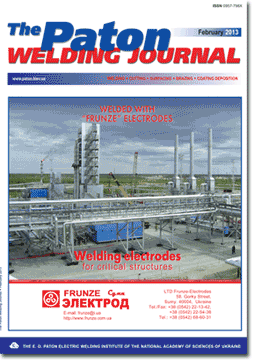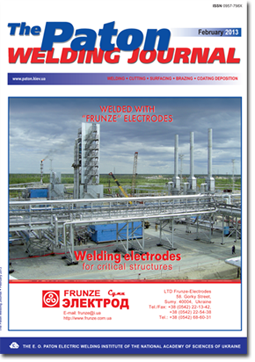| 2013 №02 (06) | 2013 №02 (08) |

The Paton Welding Journal, 2013, #2, 37-41 pages
DEVELOPMENT OF THE TECHNOLOGY OF BRAZING DIAMOND-HARD ALLOY CUTTERS
B.V. STEFANIV
E.O. Paton Electric Welding Institute, NASU, Kiev, Ukraine
Abstract
Brazing temperature influence on performance of diamond-hard alloy plates (DHAP) and diamond-hard alloy cutters (DHAC) was studied. It is established that application of copper-zinc and copper-manganese filler metals for brazing the composite cutter is not optimum because of the high heating temperature that leads to marked degradation of physico-mechanical properties of DHAP diamond layer because of graphitization. Technology of brazing DHAP with hard alloy mandrel (HAM) was developed that ensures the required properties of the diamond layer as a cutting tool. Technology of DHAC brazing (DHAP + HAM) was developed allowing performance of DHAC brazing with HAM and preserving its service properties on a high level. A lot of attention was given to assessment of performance of DHAC diamond layer after heating for brazing by gauging of a certain rock. It is shown that the proposed technology of DHAC brazing with diamond layer cooling allows application of filler metals with more than 700 °C brazing temperature without loss of this layer performance. During investigations standard filler metals and those developed at the E.O. Paton Electric Welding Institute were tested. Generalization of a set of tests led to the conclusion that Ag-Cu-Zn-Ni-Sn-Mn and Ag-Cu-Zn-Ni-Mn-Pd system filler metal are the most promising. Developed technology has been applied for items and tested under the actual service conditions. 9 Ref., 2 Tables, 4 Figures.
Keywords: brazing, brazing filler metal, superhard materials, diamond layer, diamond-hard alloy cutter, diamond-hard alloy plate, hard alloy mandrel, graphitization, drill bit, thermal stability
Received: 29.11.12
Published: 28.02.13
References
1. TU 88.1244-91: Diamond-hard alloy cutter inserts. Kiev.
2. Novikov, N.V. (2005) Tools from superhard materials. Moscow: Mashinostroenie.
3. Artyukhov, V.P., Pruss, O.P. (1997) Examination of brazing processes of diamond-hard alloy cutters. Sverkhtv. Materialy, 2, 38-43.
4. Najdich, Yu.V., Umansky, V.P., Lavrinenko, I.A. (1988) Strength of diamond-metallic contact and brazing of diamonds. Kiev: Naukova Dumka.
5. Khorunov, V.F., Maksymova, S.V., Stefaniv, B.V. (2010) Manufacture of drill bits for production of dispersed methane in mine working. The Paton Welding J., 6, 41-43.
6. Khorunov, V.F., Maksymova, S.V., Stefaniv, B.V. (2010) Effect of tin additions on structure and technological properties of brazing filler metals of Ag-Cu-Zn system. Ibid., 7, 16-21.
7. Khorunov, V.F., Maksymova, S.V., Stefaniv, B.V. (2012) Effect of palladium on structure and technological properties of Ag-Cu-Zn-Ni-Mn system brazing filler alloys. Ibid., 9, 20-25.
8. Vologdin, V.V., Kushch, E.V. (1979) Induction brazing. Leningrad: Mashinostroenie.
9. STP 28.5 05417377 100-2003: Method for assessment of wear resistance of diamond-hard alloy inserts.
Suggested Citation
B.V. STEFANIV (2013) DEVELOPMENT OF THE TECHNOLOGY OF BRAZING DIAMOND-HARD ALLOY CUTTERS. The Paton Welding J., 02, 37-41.The cost of subscription/purchase order journals or individual articles
| Journal/Currency | Annual Set | 1 issue printed |
1 issue |
one article |
| TPWJ/USD | 384 $ | 32 $ | 26 $ | 13 $ |
| TPWJ/EUR | 348 € | 29 € | 24 € | 12 € |
| TPWJ/UAH | 7200 UAH | 600 UAH | 600 UAH | 280 UAH |
| AS/UAH | 1800 UAH | 300 UAH | 300 UAH | 150 UAH |
| AS/USD | 192 $ | 32 $ | 26 $ | 13 $ |
| AS/EUR | 180 € | 30 € | 25 € | 12 € |
| SEM/UAH | 1200 UAH | 300 UAH | 300 UAH | 150 UAH |
| SEM/USD | 128 $ | 32 $ | 26 $ | 13 $ |
| SEM/EUR | 120 € | 30 € | 25 € | 12 € |
| TDNK/UAH | 1200 UAH | 300 UAH | 300 UAH | 150 UAH |
| TDNK/USD | 128 $ | 32 $ | 26 $ | 13 $ |
| TDNK/EUR | 120 € | 30 € | 25 € | 15 € |
AS = «Automatic Welding» - 6 issues per year;
TPWJ = «PATON WELDING JOURNAL» - 12 issues per year;
SEM = «Electrometallurgy Today» - 4 issues per year;
TDNK = «Technical Diagnostics and Non-Destructive Testing» - 4 issues per year.


